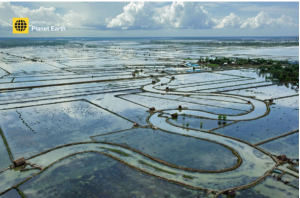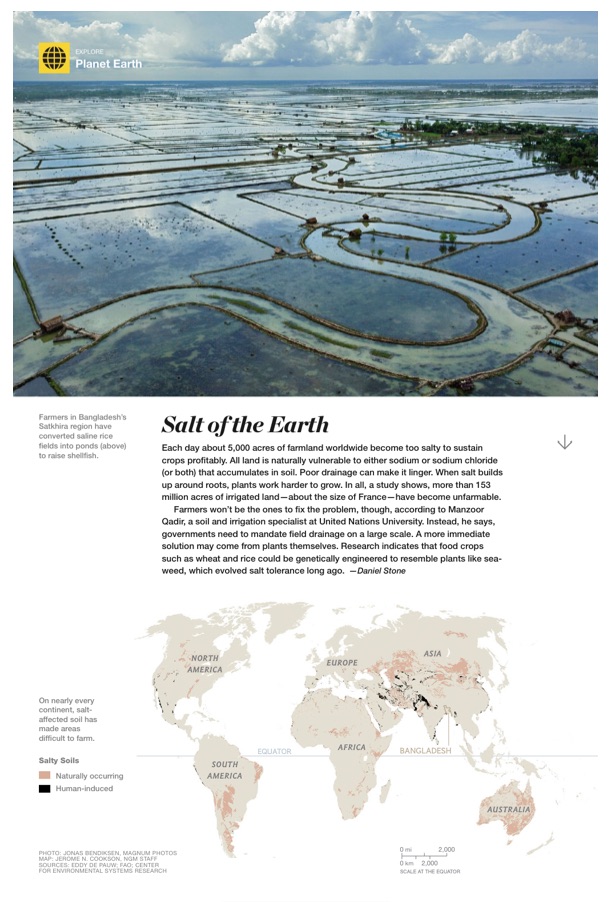United Nations University
Institute for Water, Environment and Health, Hamilton CANADA
Salt-spoiled soils worldwide: 20 percent of all irrigated lands — an area equal to France; Extensive costs include $27 billion+ in lost crop value per year
 Every day for more than 20 years, an average of 2,000 hectares of irrigated land in arid and semi-arid areas across 75 countries have been degraded by salt, according to a study by UN University’s Canadian-based Institute for Water, Environment and Health, published Oct. 28.
Every day for more than 20 years, an average of 2,000 hectares of irrigated land in arid and semi-arid areas across 75 countries have been degraded by salt, according to a study by UN University’s Canadian-based Institute for Water, Environment and Health, published Oct. 28.
Today an area the size of France is affected — about 62 million hectares (20%) of the world’s irrigated lands, up from 45 million hectares in the early 1990s.
Salt-degradation occurs in arid and semi-arid regions where rainfall is too low to maintain regular percolation of rainwater through the soil and where irrigation is practiced without a natural or artificial drainage system.
Irrigation practices without drainage management trigger the accumulation of salts in the root zone, affecting several soil properties and reducing productivity.
“To feed the world’s anticipated nine billion people by 2050, and with little new productive land available, it’s a case of all lands needed on deck,” says principal author Manzoor Qadir, Assistant Director, Water and Human Development, at UN University’s Canadian-based Institute for Water, Environment and Health. “We can’t afford not to restore the productivity of salt-affected lands.”
The study, “Economics of Salt-induced Land Degradation and Restoration,”is published Tuesday Oct. 28 in the UN Sustainable Development journal ‘Natural Resources Forum,’
Zafar Adeel, Director of UNU-INWEH, notes the UN Food and Agriculture Organization projects a need to produce 70% more food by 2050, including a 50% rise in annual cereal production to about 3 billion tonnes.
“Each week the world loses an area larger than Manhattan to salt-degradation. A large portion of the affected areas in developing countries have seen investments made in irrigation and drainage but the infrastructure is not properly maintained or managed. Efforts to restore those lands to full productivity are essential as world population and food needs grow, especially in the developing world.”
Well known salt-degraded land areas include:
- Aral Sea Basin, Central Asia,
- Indo-Gangetic Basin, India
- Indus Basin, Pakistan
- Yellow River Basin, China
- Euphrates Basin, Syria and Iraq
- Murray-Darling Basin, Australia, and
- San Joaquin Valley, United States
The paper, authored by eight experts based in Canada, Jordan, Pakistan and Sri Lanka, details crop productivity losses at farm, regional, and global scales, the cost of doing nothing, and the net economic benefit of preventing and/or reversing land degradation.
The estimated cost of crop losses was drawn from a review of more than 20 studies over the last 20 years in Australia, India, Pakistan, Spain, Central Asia and the USA.
Globally, irrigated lands cover some 310 million ha, an estimated 20% of it salt-affected (62 million ha). The inflation-adjusted cost of salt-induced land degradation in 2013 was estimated at $441 per hectare, yielding an estimate of global economic losses at $27.3 billion per year.
In India’s Indo-Gangetic Basin, crop yield losses on salt-affected lands for wheat, rice, sugarcane and cotton grown on salt-affected lands could be 40%, 45%, 48%, and 63%, respectively. Employment losses could be 50-80 man-days per hectare, with an estimate 20-40% increase in human health problems and 15-50% increase in animal health problems.
In the Indus Basin in Pakistan, wheat grain yield losses from salt-affected lands ranged 20-43% with an overall average loss of 32%. For rice, the crop yield losses from salt-affected lands ranged 36-69% with an overall average loss of 48%.
Even in the USA’s Colorado River Basin, studies show the annual economic impact of salt-induced land degradation in irrigated areas at US $750 million.
“It is important to note that the above numbers on global cost of salt-induced land degradation refer to economic losses based on crop yield losses only,” the paper says.
“However, the crop yields from irrigated areas not affected by salinization have increased since 1990 due to factors such as improved crop varieties, efficient on-farm practices, better fertilizer use, and efficient water management practices. Consequently, there may be larger gaps in crop yields harvested from salt-affected and non-affected areas under similar agro-ecosystems, suggesting an underestimation of the economic cost of salt-induced land degradation.”
“These costs are expected to be even higher when other cost components such as infrastructure deterioration (including roads, railways, and buildings), losses in property values of farms with degraded land, and the social cost of farm businesses are taken into consideration. In addition, there could be additional environmental costs associated with salt-affected degraded lands as these lands emit more greenhouse gases, thus contributing to global warming.”
Among methods successfully used to facilitate drainage and reverse soil degradation: Tree planting, deep plowing, cultivation of salt-tolerant varieties of crops, mixing harvested plant residues into topsoil, and digging a drain or deep ditch around the salt-affected land.
Reversing land degradation and bringing salt-affected lands back into highly productive state are expected to result in favorable environmental benefits in addition to economic gains, although functional markets for many of the ecosystem services are currently embryonic or nonexistent.
Although there is a cost of investing in preventing land degradation, reversing land degradation, or restoring degraded land into productive land, these costs of action are much less than the costs of letting land degradation continue and intensify.
Pertinent policies, well-designed salinity management plans, supportive institutions, skilled human resources, provision of facilities and infrastructure for disposal of salts, capacity development of farmers, and utilization of locally available resources and indigenous knowledge of communities are crucial in combating salt-induced land degradation.
Salt-induced land degradation may also affect the business sector negatively either directly or indirectly, targeting their inputs, outputs, or processes. The businesses in close connection with natural resources may be affected, such as those dealing with basic resources (forestry, wood, pulp, and paper), food and beverage, construction and materials, industrial goods and services (transportation and packaging), utilities (water and electricity), personal and household goods (clothing, footwear, and furniture), leisure and travel (hotels and restaurants), and real estate. Therefore, reversing salt-induced land degradation would help these sectors achieve potential economic gains by providing needed levels of materials and services.
###
Authors of the paper:
- Manzoor Qadir and Emmanuelle Quillérou, United Nation University Institute for Water, Environment and Health, Ontario, Canada
- V. Nangia and M. Singh, International Center for Agricultural Research in the Dry Areas, Amman, Jordan
- G. Murtaza, Institute of Soil and Environmental Sciences, University of Agriculture, Faisalabad, Pakistan
- Richard Thomas, CGIAR Research Program on Dryland Systems, c/o International Center for Agricultural Research in the Dry Areas, Amman, Jordan.
- P. Drechsel and A.D. Noble, International Water Management Institute, Colombo, Sri Lanka
The United Nations University Institute for Water, Environment and Health, a member of the UNU family of organizations, is the UN Think Tank on Water, created in 1996. The institute’s mission: to contribute to efforts to resolve pressing regional and global water challenges of concern to the UN, its Member States, and their people, through targeted research, capacity development, knowledge enhancement and transfer, and public outreach. UNU-INWEH is hosted by the Government of Canada and McMaster University.
* * * * *
News release in full, click here
Coverage summary, click here
Example coverage by:
BBC: click here
The Independent, UK, click here
New Scientist: click here
Daily Mail, UK, click here
NTV Kenya – (2 minute television news item), click here
National Public Radio, USA, click here
Al Jazeera: click here
Climatewire, USA, click here
Climate News Network, USA, click here
Global Magazin, Germany, click here
Novinky, Czech Republic, click here
National Geographic, Dutch, click here; Spanish, click here;
English print edition, May 2015: click here

